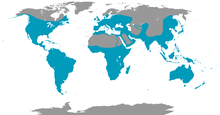Alcedinidae
| Kingfisher | |
|---|---|
 |
|
| Azure kingfisher (Ceyx azureus) | |
| Scientific classification | |
| Kingdom: | Animalia |
| Phylum: | Chordata |
| Class: | Aves |
| Order: | Coraciiformes |
| Suborder: | Alcedines |
| Family: |
Alcedinidae Rafinesque, 1815 |
| Subfamilies | |
 |
|
| Global distribution of the kingfishers | |
Alcedininae
Halcyoninae
Cerylinae
Kingfishers are a group of small to medium-sized, brightly colored birds in the order Coraciiformes. They have a cosmopolitan distribution, with most species found outside of the Americas. The group is treated either as a single family, the Alcedinidae, or as a suborder Alcedines containing three families, Alcedinidae (river kingfishers), Halcyonidae (tree kingfishers), and Cerylidae (water kingfishers). Roughly 90 species of kingfishers are described. All have large heads, long, sharp, pointed bills, short legs, and stubby tails. Most species have bright plumage with few differences between the sexes. Most species are tropical in distribution, and a slight majority are found only in forests. They consume a wide range of prey, as well as fish, usually caught by swooping down from a perch. While kingfishers are usually thought to live near rivers and eat fish, most species live away from water and eat small invertebrates. Like other members of their order, they nest in cavities, usually tunnels dug into the natural or artificial banks in the ground. A quarter of all kingfishers nest in abandoned termite nests. A few species, principally insular forms, are threatened with extinction. In Britain, the word "kingfisher" normally refers to the common kingfisher.
The family Alcedinidae was introduced (as Alcedia) by the French polymath Constantine Samuel Rafinesque in 1815.
...
Wikipedia
